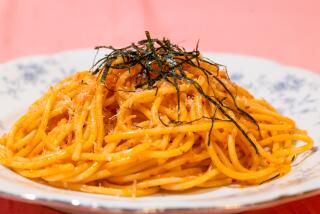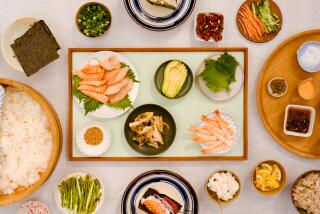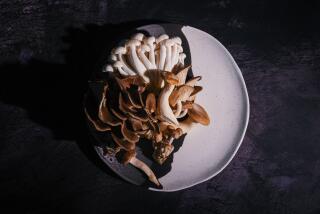The Many Faces of Shiitake
- Share via
The Chinese and Japanese have known for centuries that drying shiitake mushrooms is a great way to preserve them. But drying does much more than prevent the mushrooms from spoiling. Somehow it changes their character: It intensifies their taste and aroma. From a culinary standpoint, it turns them into a new ingredient.
For several purposes--especially for flavoring soups, stews and sauces--many cooks prefer dried shiitake mushrooms to fresh ones. These mushrooms are a “gourmet” convenience food. In contrast to fragile fresh mushrooms, which need to be used within a few days, dried mushrooms can keep for years in a dark, fairly cool place. They are a boon to cooks who have little time to spend carefully wiping mushrooms individually, as should be done with fresh shiitakes.
Dried shiitake mushrooms, also known as Chinese black mushrooms, forest mushrooms and dried Asian mushrooms, can be found at many supermarkets. They tend to be much less expensive than other dried mushrooms. If you buy them in Chinese grocery shops or discount stores, they usually cost even less. Their color can be brown, black or gray, and they come in several grades. Those with thick caps are best used whole, while thinner ones are generally cut into pieces for cooking.
There’s no mystery to using these fragrant mushrooms: Soak them in hot water for 20 minutes until they are soft enough so that you can easily cut off their stems. Then briefly simmer or stir-fry so they can absorb seasonings. They can stand on their own as the star of the meal or can be used as a flavoring to enhance other ingredients, including meat, poultry, fish and vegetables.
Shiitake mushrooms are prized in vegetarian cooking for their meaty texture and smoky flavor, which help make meatless dishes satisfying and delicious. They are a great addition to vegetable stews, prepared with either Asian or Western seasonings.
You have probably come across Chinese recipes that call for shiitake mushrooms and a long list of other ingredients. But there are plenty of easy ways to use them. You can make a fabulous, quick appetizer of whole shiitake mushrooms stewed with soy sauce, rice wine and sesame oil. Or add them to everyday recipes to give them a new twist. Simmer shiitake mushrooms in vegetable soup or spaghetti sauce. Cook them with potatoes or carrots to transform the humble vegetables into an elegant dish.
Use dried shiitake mushrooms to make wonderful sauces. If you’re cooking beef with red wine, substitute shiitake mushrooms for the usual white ones. When you prepare mushroom cream sauce for pasta, add soaked shiitake mushrooms along with common white or brown mushrooms; you’ll be delighted with the difference in the sauce’s flavor and aroma.
Here are some other tips:
* Rinse dried shiitake mushrooms after soaking to be sure they are not sandy.
* The stems of shiitake mushrooms are tough; after soaking the mushrooms, cut them off and discard.
* Save the soaking liquid from the mushrooms to add flavor to soups and sauces. Pour the liquid into a cup, leaving any sandy liquid at the bottom of the bowl in which the mushrooms were soaked.
CARROT AND POTATO STEW WITH SHIITAKE MUSHROOMS
1 ounce dried shiitake mushrooms
Water
1 tablespoon oil
1 small onion, chopped
1 pound carrots, halved lengthwise, then cut into 1/2-inch slices
3/4 pound potatoes, peeled and diced
1 bay leaf
Salt
Freshly ground pepper
1 tablespoon butter, margarine or oil
4 teaspoons flour
3 tablespoons chopped parsley
Dried shiitake mushrooms turn vegetable stews, like this eastern European casserole of root vegetables, into festive dishes. You can prepare other stews the same way by substituting turnips, celery root, kohlrabi or parsnips for the potatoes or carrots.
Rinse mushrooms. Soak in pot of hot water to cover 20 minutes. Remove mushrooms. Rinse again. Cut off stems. Slice mushrooms.
Heat oil in saucepan. Add onion and saute 5 minutes over medium heat. Add soaked mushrooms, carrots, potatoes, 1 1/2 cups water, bay leaf and salt and pepper to taste. Bring to boil. Cover and cook until vegetables are tender, 20 minutes. With slotted spoon, transfer vegetables to bowl. Discard bay leaf. Measure 1 cup liquid and reserve remaining liquid.
Melt butter in same pan. Add flour and cook, stirring constantly, until lightly browned. Whisk in 1 cup measured cooking liquid. Bring to boil, whisking. Return vegetables to pan. Stir gently and bring to simmer. Stir in 1 tablespoon reserved liquid, if sauce is too thick. Adjust seasonings to taste. Stir in half of parsley. Serve sprinkled with remaining parsley.
Makes 4 to 5 servings.
Each of 5 servings contains about:
168 calories; 120 mg sodium; 6 mg cholesterol; 5 grams fat; 18 grams carbohydrates; 4 grams protein; 2.47 grams fiber.
SHIITAKE MUSHROOMS WITH SESAME SEEDS
20 dried shiitake mushrooms
Water
1 1/2 teaspoons sesame seeds
4 teaspoons vegetable oil
2 teaspoons minced peeled ginger root
2/3 cup vegetable or chicken stock
2 tablespoons soy sauce
2 tablespoons rice wine or Sherry
2 teaspoons sugar
1 teaspoon sesame oil
Rinse mushrooms. Soak in hot water to cover 20 minutes. Remove mushrooms, reserving liquid. Rinse again. Cut off stems.
Toast sesame seeds in small dry skillet over medium heat, shaking pan often, until golden brown, about 3 minutes. Transfer immediately to plate.
Heat vegetable oil in heavy medium saucepan over medium heat. Add ginger root and cook and stir 15 seconds. Add soaked mushrooms, stock, soy sauce, wine and sugar. Bring to boil.
Cover and cook over low heat, stirring occasionally, until mushrooms are tender, about 5 minutes. Add 2 to 3 tablespoons reserved liquid if pan becomes dry. Remove from heat. Add sesame oil and toss. Serve hot or cold, sprinkled with sesame seeds.
Makes 4 servings.
Each serving contains about:
162 calories; 634 mg sodium; 0 mg cholesterol; 8 grams fat; 18 grams carbohydrates; 4 grams protein; 2.47 grams fiber.


